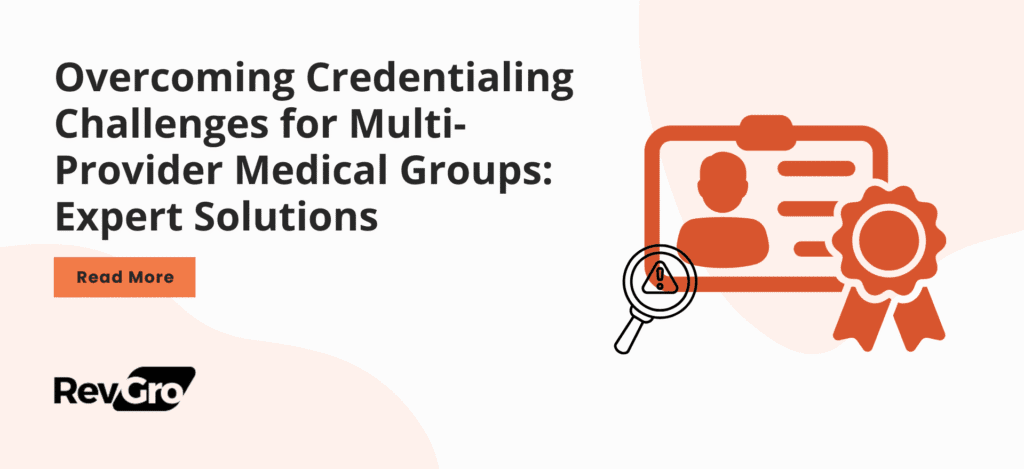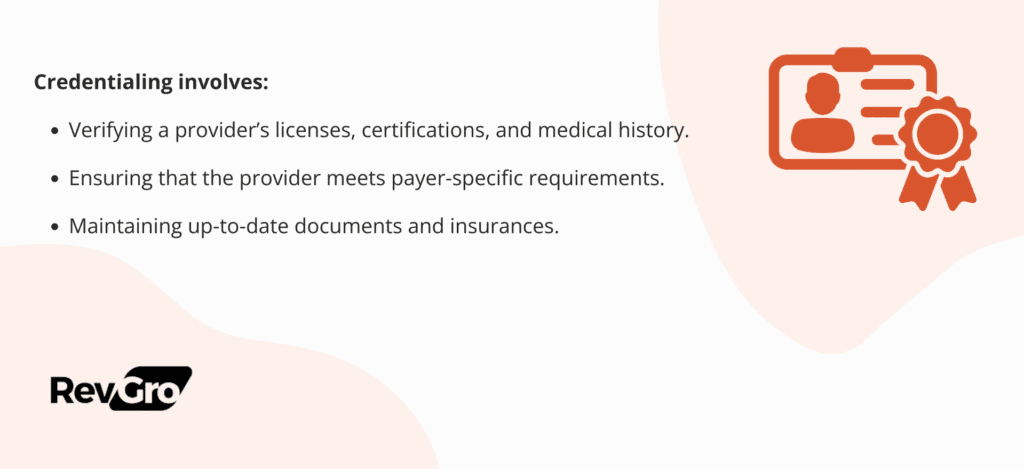
- Understanding the Credentialing Process for Multi-Provider Groupst
- Streamlining Credentialing with Automation and Technology
- Centralized Credentialing for Efficiency
- Partnering with Credentialing Experts
- Managing Provider-Specific Requirements Across Multiple Payers
- Maintaining Continuous Compliance
- Conclusion: Overcoming Credentialing Challenges to Support Practice Growth
Credentialing is a crucial process for all healthcare providers, ensuring they are authorized to offer services to patients covered by insurance plans. For multi-provider medical groups, however, credentialing can be an especially complex and time-consuming process. As these practices grow, managing the credentialing of multiple providers, across different specialties, and with various payer requirements can quickly become overwhelming.
In this blog, we’ll explore the unique credentialing challenges faced by multi-provider medical groups and provide expert solutions to streamline the process, ensuring efficiency, compliance, and revenue generation.
Understanding the Credentialing Process for Multi-Provider Groups

Credentialing is the process through which healthcare providers are validated by insurance payers to ensure they meet the necessary standards and regulations to provide healthcare services. For multi-provider groups, credentialing is not just about getting one or two providers approved, but instead requires comprehensive management for all providers under one umbrella.
Credentialing involves:
- Verifying a provider’s licenses, certifications, and medical history.
- Ensuring that the provider meets payer-specific requirements.
- Maintaining up-to-date documents and insurances.
The Unique Challenges for Multi-Provider Groups:
- Multiple Providers with Diverse Specialties: Each provider in your group might have different credentialing requirements based on their specialty. For example, the credentialing process for a neurologist may differ from that of an orthopedic surgeon.
- Managing Multiple Applications: The sheer volume of paperwork and documentation for multiple providers and payers can be overwhelming.
- Payer Variability: Each insurance company has its own set of requirements and submission timelines, making the process more complicated.
The traditional manual process of credentialing can be labor-intensive, requiring significant resources. Fortunately, technology and automation have provided innovative solutions to make the credentialing process much more efficient.
Solutions to Simplify the Credentialing Process:
- Credentialing Software: Utilize credentialing management software that allows you to store all provider information in one place. This software can automatically track expiry dates, renewals, and help you manage multiple providers simultaneously.
- Automated Updates: Many systems now offer automated reminders for credential renewal deadlines and updates, reducing the chances of missed updates and preventing disruptions to your practice.
- Electronic Data Sharing: By using electronic systems for submitting credentialing applications, you reduce paperwork and improve accuracy, leading to faster processing and fewer errors.
By embracing technology, multi-provider groups can manage credentialing in a more organized and efficient way, saving time and ensuring compliance.
For multi-provider groups, one of the biggest challenges is maintaining cohesion and efficiency when managing credentialing for several providers. One solution to this challenge is implementing centralized credentialing.
Benefits of Centralized Credentialing:
- Single Point of Contact: Centralized credentialing allows for a single team or individual to manage the credentialing process for all providers, streamlining the workflow.
- Consistency in Compliance: A single team can ensure that all providers meet payer-specific requirements and that the group maintains a consistent approach to credentialing.
- Faster Processing: With all credentialing handled by one department, it can significantly reduce delays and increase the speed of the process, especially when submitting documents to insurers.
Implementing centralized credentialing allows practices to have one standardized process, making the entire system more efficient, cohesive, and scalable.
The integration of credentialing and RCM leads to operational efficiency—one of the most significant advantages for healthcare providers. When these two functions work seamlessly, administrative workloads decrease, and the practice’s financial management becomes smoother.
Automating Credentialing and RCM Processes
- Faster and Error-Free Onboarding and Enrollment: Using automated credentialing software allows practices to streamline the application and verification process, ensuring that credentialing tasks are completed faster and with fewer errors.
- RCM Tools that simplify collections and claims: By integrating RCM tools into your practice management system, you can automate the claims submission, follow-ups, and collections processes, freeing up your staff to focus on patient care rather than administrative tasks.
When your credentialing process is automated and integrated with your RCM system, you can reduce administrative overhead and focus on providing quality care while ensuring that the revenue cycle runs efficiently.
Credentialing and RCM: A Collaborative Approach to Patient Satisfaction
Although credentialing and RCM primarily focus on the financial side of your practice, they also have a direct impact on patient satisfaction.
How Proper Credentialing Enhances the Patient Experience
- Easier Access to Care: Credentialing removes insurance-related stress for patients, allowing them to schedule care confidently with in-network providers.
- Faster Service Delivery: A streamlined credentialing process and efficient RCM system lead to faster billing and less paperwork for patients, making their overall experience more convenient.
RCM’s Role in Improving Patient Experience
- Clear Billing Statements: A well-run RCM process ensures that patients receive clear and accurate billing statements. This transparency reduces confusion and the likelihood of payment disputes.
- Efficient Payment Collection: Automated RCM systems allow for easy online payments, payment plans, and reminders, improving patient satisfaction and increasing the likelihood of timely payments.
Building a Stronger Financial Future with Credentialing and RCM
Credentialing and RCM are not just back-office tasks—they’re strategic levers that power your practice’s financial success and patient satisfaction. Credentialing ensures that your practice can access the right payer networks and submit claims for timely reimbursement, while RCM ensures these claims are processed correctly and payments are collected swiftly.
For long-term financial success, practices must view credentialing and RCM as complementary functions that support each other. By streamlining both, practices can enjoy a smoother revenue cycle, reduce administrative costs, improve cash flow, and ultimately boost patient satisfaction.
RevGroMD helps you simplify, streamline, and scale your credentialing and RCM—so you can focus on delivering care, not chasing claims. Let’s grow your revenue together.
